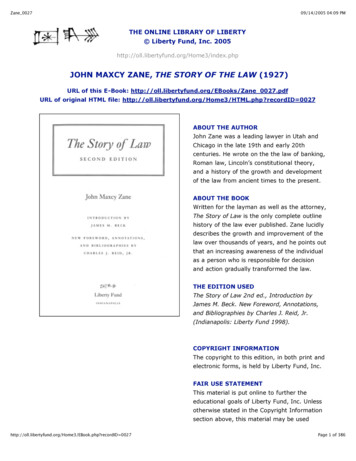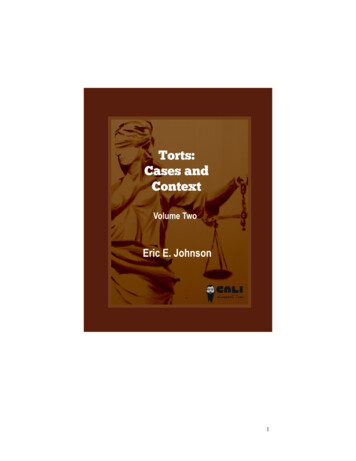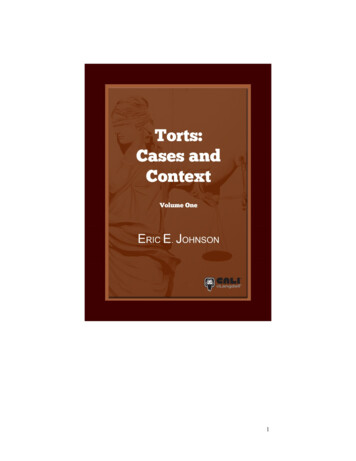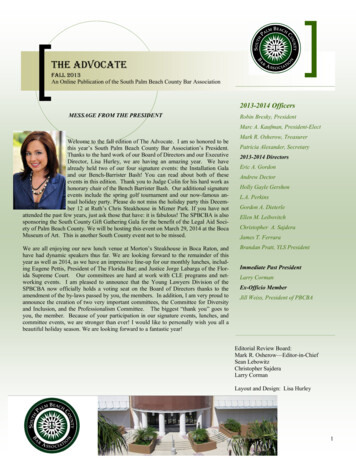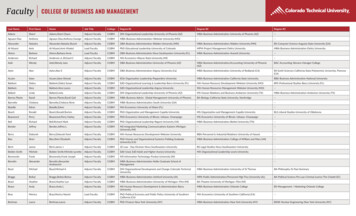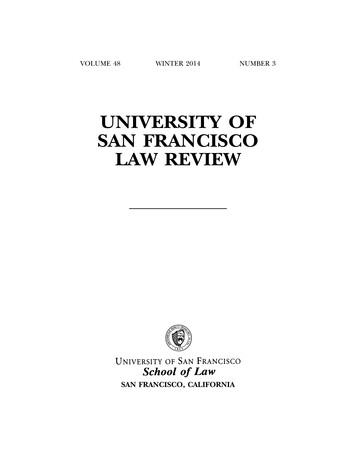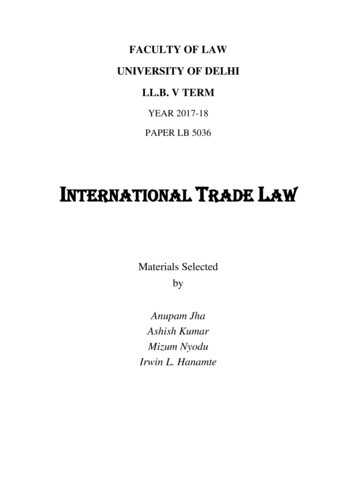
Transcription
FACULTY OF LAWUNIVERSITY OF DELHILL.B. V TERMYEAR 2017-18PAPER LB 5036INTERNATIONAL TRADE LAWMaterials SelectedbyAnupam JhaAshish KumarMizum NyoduIrwin L. Hanamte
INTERNATIONATIONAL TRADE LAWLL.B. Vth TERM2016-17Dr. Anupam JhaDr. Ashish KumarMr. MiijumPART IPrescribed Books:1. Raj Bhala, International Trade Law: An Interdisciplinary Non-Western Textbook (Vols 1 & 2)Lexis Nexis (2015)2. Schnitzer Simone, Understanding International Trade Law (2nd ed.) Universal (2010)3. Carole Murray, David Holloway, The Law and Practice of International Trade, (12th edn.)Sweet & Maxwell (2015)4. Autar Krishen Kaul, A Guide to the W.T.O. and GATT: Economics, Law, and Politics, KluwerLaw International (2006)5. Dr. S.R. Myneni, International Trade Law (International Business Law) (3rd edn.) AllahabadLaw Agency (2014)Topic 1: Origin and Evolution of GATT & WTO.1.11.21.31.41.51.61.7Global Economics and International Trade LawProtectionism vs Free TradeBirth of GATT, 1947GATT Rounds of Negotiation Including Doha Round and AfterThe WTO: Its Genesis (Uruguay Round 1986 to 1994)The WTO Charter and GATT 1994, WTO Agreements, Understandings, AnnexesObjective, Function and Structure of WTO (Key Organs or Bodies), Membership,Decision Making Process, Voting, Amendment, Waiver etc.Topic 2: The Principles on Non-Discrimination in GATT & WTO2.1. Most-favoured-Nation Treatment (MFN) Article 1 of GATT 1947: its background andhistory, meaning, scope, significance & advantages,; meaning and scope of ‗like product‘.2.2. Exceptions to MFN (Annexes A to F of Article 1, Customs Unions and Free Trade Areas(Art. XXXIV), Generalized System of Preferences (Art XXV), Art. XXXV, Art XXV, Art.XX, Art XXI, XII-XVIII, Art. VI, Subsidies Code and Government Procurement Code, ArtXXIII, XIX (Escape Clause); Also Discuss Regional Associations like NAFTA, BRICS,SAFTA, TTIP etc.2.3. National treatment principle (NT) Article III, GATT: its Origin & Scope, Meaning,Methodology.2.4. Exceptions to National Treatment Principle.
Cases:1.Application of Article 1:1 to Rebates on Internal Taxes [India Tax Rebates onExports] (1948); II GATT B.I.S.D. 12Japan-Taxes on Alcoholic Beverages case, Complaints by the European2.Communities, Canada, and the United States against Japan, (WT/DS8, DS10, DS11),Appellate Body and Panel Reports adopted on 1 November, 1996.3.US Taxes on Automobiles case, Complaints by the European Community againstUS, WT/DS 31/R, 11 Oct., 1994European Communities — Regime for the Importation, Sale and Distribution ofBananas case, Complaint by Ecuador, Guatemala, Honduras, Mexico, UnitedStates against European Community, WT/DS 27, 5 Feb., 1996Korea-Measures Affecting Imports of Fresh, Chilled and Frozen Beef case(Korea-Beef case), Complaint by US & Australia against South Korea, WT/DS161, 11 Dec., 2000India – Measures Affecting the Automotive Sector case, Complaint by US & EUagainst India, WT/DS146/R, 5 April, 2002European Communities – Measures Prohibiting the Importation and Marketing ofSeal Products, WT/DS400/AB/R and WT/DS401/AB/R (adopted 18 June 2014)4.5.6.7.Topic 3: Dispute Settlement Procedures under GATT and WTO3.1Dispute settlement under GATT: Article XXII,Article XXIII, its merit & de-merit3.2Difference between the GATT and WTO dispute settlement procedures3.2.1 Dispute Settlement Procedure under the WTO charter (refer Agreement on DisputeSettlement Understanding), Consultation, Dispute Panel Body, Appellate Body,Implementation of findings/decisions of WTO Dispute Settlement Body (ReferArticle XXV GATT)Topic 4: Agreement on Subsidies and Countervailing Measures4.14.24.34.4Identification of Subsidies that are subject to the SCM Agreement.Definition of ‗Subsidy‘, ‗Specificity‘.Regulation of Specific Subsidiesi. Prohibited Subsidiesii. Actionable Subsidiesiii. Non- actionable SubsidiesDispute Settlement and RemediesCases:1. U.S. –Countervailing Measures on Certain Hot-Rolled Carbon Steel FlatProducts From India, WT/DS 436/AB/R (19 December 2014)2. Canada- Certain Measures Relating to the Renewable Energy Sector,WT/DS412/AB/R (24 May 2013)3. European Communities – Measures Affecting Trade in Large Civil Aircraft,WT/DS316/AB/R (adopted 18 May 2011)
Topic 5: Agreement on Dumping and Anti-Dumping Duties5.15.25.35.4Anti-dumping: A Basic OverviewAnti-dumping Investigationsi)Initiationii)Evidence used in the Investigationiii)Key substantive issues: Dumping, injury and causationAnti- dumping Measuresi)Provisional measuresii)Price undertakingsiii)Duration & review of dutiesiv)The use of Anti-dumping Measures other than Tariff DutiesChallenging AD measures in WTO Dispute Settlementv)Standard of Reviewvi)The measures to be challengedvii)Good faith, Even-handedness, ImpartialityCases1. United States-Anti-Dumping and Countervailing Measures on Steel Plate from Indiacase, Complaint by India against US, WT/DS 206, 19 Feb., 20032. United States-Continued Dumping and Subsidy Offset Act of 2000 case, Complaint byAustralia, Brazil, Chile, European Communities, India, Indonesia, Japan, Korea,Thailand against US, WT/DS 217, 21 Dec., 2000 (Authorization to retaliate grantedon 26 November 2004)3. United States- Countervailing and Anti-dumping Measures on Certain Products fromChina case, Complaint by China against US, WT/DS 449, 7 July, 2014.4. China-Anti-Dumping and Countervailing Duties on Certain Automobiles from theUnited States case, Complaint by US against China, WT/DS 440, 18 June, 2014Topic 6: General Agreement on Trade and Services (GATS)6.1The scope of GATS6.2General obligations and disciplinesi.ii.iii.MFN Principle (GATS Article II & Annex)Domestic regulations (GATS Article VI)Exceptions (GATS Article XIV)6.3. Specific commitments (GATS Parts III-IV)i)Market accessii)National treatmentiii)Additional commitmentsCases:1. US- Measures Affecting The Cross-Border Supply of Gambling and BettingServices, WT/DS285/AB/R (adopted on 20 April 2005)Topic 7: Agreement on Trade-Related Investment Measures (TRIMs)
7.1. Objective and Coverage of TRIMs7.2. National Treatment and Quantitative Restrictions, Inconsistent TRIMs7.3. Notification & Transitional Agreements, Transparency7.4. Provision for Developing Country MembersCase:1. India-Certain Measures Relating to Solar Cells and Solar Modules case,Complaint by US against India, WT/DS 456, 6 Feb. 2013 (Panel Report has beenappealed by India on 20 April, 2016)PART- II1. Indira Carr, International Trade Law, (5th edn.) Routledge (2014)2. Jason Chuah, Law of International Trade, (5th edn.) Sweet & Maxwell (2013)3. Dr. S.R. Myneni, International Trade Law (International Business Law) (3rd edn.)Allahabad Law Agency (2014)Topic 7: Export Trade transactions and International Commercial Contracts7.17.27.37.4Types of International ContractsStandard Trade Terms (CIF, FOB, FAS)Formation and Enforcement of International contractsRights Liabilities of Parties to ContractsTopic 8: Payments in International Trade8.18.28.38.4Bills of ExchangeLaw Relating to Bills of ExchangeCommercial Credit in International TradeLetter of Credit: Types and the Law Relating to Commercial CreditTopic 9: Carriage of Goods in Export Trade9.19.29.3Carriage of Goods by SeaBills of lading and Charter PartiesRights and Liabilities of the Parties to Contract of Carriage
INDEX1. WTO: Objective, Functions & Organizational Structure2. Agreement Establishing the WTO, 1994 (Text)3. General Agreement on Tariffs and Trade, 1994 (Text)4. Principle of Most Favoured Nation5. Principle of National Treatment6. Understanding on Rules & Procedures Governing theSettlement of Disputes (Text)7. Dispute Settlement System in the WTO (Reading)8. Dumping & Anti-Dumping in the GATT/WTO9. General Agreement on Trade in Services (Text)10. GATS (Reading)11. Agreement on Trade Related Investment Measures (Text)12. TRIMS (Reading)13. European Communities — Regime for the Importation,Sale & Distribution of Bananas, WT/DS 27, 5 Feb., 199614. India – Measures Affecting the Automotive SectorWT/DS146/R, 5 April, 200215. U.S. –Countervailing Measures on Certain Hot-Rolled CarbonSteel Flat Products from India, WT/DS 436/AB/R (19 December 2014)16. India-Certain Measures Relating to Solar Cells and SolarModules, WT/DS 456, 6 Feb. 2013
LL.B. V Term Examination, 2016Paper L.B. 5036 - International Trade LawTime: 3 hoursMaximum Marks: 100Note: Attempt at least one question from each part and five questions in all.PART IQ. No. 1. (a) What is the scope and function of WTO? Discuss inbrief the organizational structure of the WTO.(b) ―The Uruguay Round of Negotiations finally led to the creation ofWTO‖. In the light of this statement briefly discuss the salientachievements of Uruguay Round.Q. No. 2. (a) Explain the rules and exceptions governing Principle ofNational Treatment in WTO? Refer to relevant decisions of WTO.(b) Country X takes a measure whereby meat imported from countryY is required to be sold from an exclusive separate outlet in thedomestic market of X. Country Y alleges discrimination. Examinethe validity of the measure taken by X and claims made by Y in thelight of relevant finding made by WTO in the Korea-Beef case,WT/DS 161 (2000)Q. No. 3. What are the objectives of Dispute Settlement Body of theWTO? Discuss in detail the different stages of the WTO DisputeSettlement Process.Q. No. 4. What are the elements for identification of ‗subsidy‘ underthe GATT/WTO? Explain the various types of subsidy. What are therequirements before the countervailing measure can be applied underthe framework of WTO?Q. No. 5. Write short note on any two of the following:(a) India-Solar Panel Dispute(b) Anti-Dumping and Countervailing Duties(c) „Services‘ under WTO.PART IIQ. No. 6. Explain the standard trade terms CIF, FOB and FAS,commonly used in the international contracts of sale. What are theobligations of seller and buyer under these contracts?Q. No. 7. What is a Letter of Credit (LOC) used in internationalcommerce? Discuss the advantages and disadvantages of using theLetter of Credit?
Q. No. 8. Explain the purpose and functions of a Bill of Lading inInternational Commerce? Enumerate the liabilities of a carrier underthe Bill of Lading.LL.B. V Term Examination, 2015Paper L.B. 5036 - International Trade LawTime: 3 hoursMaximum Marks: 100Note: Attempt at least one question from each part and five questions in all.PART IQ. No. 1. (a) Discuss the objectives and functions of WTO.(b) Describe the important differences between GATT and the WTO? Howthe current decision-making process under WTO is different from theGATT, 1947.Q. No. 2. Discuss the rule governing ―Most Favoured Nation Treatment‖(MFN) under the GATT, 1994. What are its exceptions? Support youranswer with the help of WTO decisions.Q. No. 3. What is dumping of goods? Discuss the scope and application ofArticle VI of GATT, 1994. Explain the process governing anti-dumpingmeasures under the WTO.Q. No. 4. The WTO dispute settlement system is considered the mostimportant part of the WTO. Explain in detail the process of disputesettlement at WTO. What are the consequences of non-adherence to WTOfindings?Q. No. 5. Write short note on any two of the following:(a) Subsidies and Countervailing Measures(b) Principle of National Treatment.(c) WTO Doha RoundPART IIQ. No. 6. What is a Bill of Lading? Explain its various types. Describe itsdifferent functions and purposes under the international carriage of goods.Q. No. 7. What do you mean by International Commercial Terms used ininternational sale contracts? Discuss the obligations of the parties underCIF, FOB and FAS contracts.Q. No. 8. (a) What is Letter of Credit in International Sales? Discuss itsvarious types.(b) Discuss the benefits of arbitration in the settlement of internationalcommercial disputes.
LL.B. V Term Examination, 2014Paper L.B. 5036 - International Trade LawTime: 3 hoursMaximum Marks: 100PART I1. Discuss briefly the developments leading to the establishment of WTO,1995. Discuss also the differences between WTO, 1995 and GATT, 1947.2. ―General Most Favoured Nation Treatment is the cornerstone of the freetrade, yet maintaining state freedom in regulating international trade‖.In the light of the above statement, discuss the salient features of MFNtreatment. Discuss also exceptions, if any, to MFN treatment.3. Discuss briefly any two of the following;(a) National Treatment(b) General Agreement on Trade in Services(c) Accession to WTO4. ―The Understanding on Rules and Procedures governing the Settlementof Trade Disputes between nations has proved to be a boon to freedom ofInternational Trade.‖In the light of the above, discuss briefly the salient features of settlement ofdisputes under WTO, 1995. What will be the legal position if there is aconflict between the Dispute Settlement Agreement of WTO and DisputeSettlement Provisions of individual agreements, which are part of WTO,1995.5. Discuss briefly any two of the following:(a) Dumping and Anti-Dumping Duties(b) Structure of WTO, 1995(c) Schedule of ConcessionsPART II6. Discuss the main elements of a C.I.F. and F.O.B. contract. Discuss alsothe responsibilities of parties to a C.I.F. contract.7. Discuss the salient features of a Letter of Credit. Discuss the Rulesgoverning the operation of a Letter of Credit.8. Discuss briefly any two of the following:(a) Commercial Arbitration(b) Rejection of Documents and Rejection of Goods(c) Bill of Lading
WTO: OBJECTIVES, FUNCTIONS & ORGANIZATION STRUCTUREI.A.WHAT IS ''WTO''?WTO is the acronym for World Trade Organization. The WTO came into being in 1995and was created after the culmination of long intense negotiations which took placeunder the auspices of the General Agreement on Tariffs and Trade (GATT).AN ORGANIZATION FOR TRADE LIBERALIZATIONThe WTO is an organization for liberalizing trade. Trade liberalization is the mainapproach that the WTO has adopted to help Member countries achieveeconomic growth and raise living standards. However, the WTO recognizesMembers' right to maintain trade barriers, subject to the conditions provided in the WTOAgreements. Such trade barriers are considered to serve legitimate objectives, such asthe protection of human, animal or plant life or health or the protection of consumers. Inso doing, a balance is struck between trade liberalization and the flexibility Membersneed to meet their policy objectives.A FORUM FOR TRADE NEGOTIATIONSThe WTO provides a multilateral forum for Member governments to negotiate rules ofinternational trade. Thus, the WTO was born out of negotiations and everything theWTO does is the result of negotiations. The WTO is currently host to new negotiationsunder the Doha Development Agenda (DDA) launched in 2001.A SET OF INTERNATIONAL TRADE RULESThese rules are contained in the WTO Agreements which were signed by the bulk of theworld's trading nations and have binding effects on them. Thus, the WTO Agreementslay down the legal ground rules for international commerce between WTOMembers. They cover trade in goods, trade in services and trade-related aspects ofintellectual property rights (TRIPS). However, it is important to note that the WTOAgreements constitute an international agreement, as such, bind only states andseparate customs territories.A PLACE FOR SETTLING TRADE DISPUTESThe WTO is also a place for settling trade disputes between Member countries. TheWTO's procedure for resolving trade disputes is vital for enforcing the rules and forensuring that trade flows smoothly.Who can be members of the WTO?International organizations are normally made up of sovereign states, that is also thecase for the WTO. The vast majority of WTO Members are states; however, alsoseparate customs territories that meet certain requirements can become Members of theWTO (see section on Accession).
I.B.PRINCIPLES OF THE WTOMOST-FAVOURED-NATION (MFN) PRINCIPLE: TREATING FOREIGNERS EQUALLYUnder the WTO Agreements, a country should not discriminate between its tradingparties. According to the MFN principle, any advantage, favour, privilege or immunitygranted by a Member to any product originating in or destined for any other countryshall be accorded immediately and unconditionally to the like product of all Members.The MFN principle is one of the cornerstones of the WTO. It is embodied in Article Iof the GATT 1994 which will be studied in Module 2, Article II of the General Agreementon Trade in Services (GATS) and Article 4 of the TRIPS Agreement, which will be studiedin Modules 6 and 7, respectively. However, as we will see, in each Agreement theprinciple is applied slightly different.NATIONAL TREATMENT PRINCIPLE: TREATING FOREIGNERS AND LOCALS EQUALLYWithin national territory, WTO Members cannot favour domestic products overimported products(Article III of the GATT 1994). The principle of national treatment also applies, withsome differences, to trade in services (Article XVII of the GATS) and intellectual propertyprotection (Article 3 of the TRIPS Agreement). The national treatment principle will beexplained in Modules 2 (Goods), 6 (GATS) and 7 (TRIPS).GENERAL PROHIBITION OF QUANTITATIVE RESTRICTIONS (QRS)WTO Members cannot prohibit, restrict or limit the quantity of productsauthorized for importation or exportation (Article XI of the GATT 1994), subject tolimited exceptions. This principle does not apply in this way in the context of the GATSand the TRIPS.OBSERVANCE OF BINDING LEVELS OF TARIFF CONCESSIONS (GOODS) AND OFSPECIFIC COMMITMENTS (SERVICES)Minimum market access conditions are guaranteed by commitments undertaken byMembers regarding customs duties (tariff concessions for goods - Article II of the GATT1994) and market access for the supply of services (specific commitments - Article XVIof the GATS). They will be explained in detailed in Modules 3 (Goods) and 6 (GATS).TRANSPARENCYIt is fundamentally important that regulations and policies are transparent. Forexample, as you will study in different Modules, WTO Members are required to inform theWTO and fellow-Members of specific measures, policies or laws through regular"notifications". In addition, the WTO conducts periodic reviews of individual Members’trade policies through the Trade Policy Review Mechanism (TPRM), which will beintroduced in Module 10.
Why Free Trade?The economic case for an open trading system based on multilaterally agreedrules not only rests on commercial common sense, but it is also supported byevidence: the experience of world trade and economic growth since the SecondWorld War. During the first 25 years after the war, world economic growthaveraged about five per cent per year, a high rate that was partly theresult of lower trade barriers. World trade grew even faster, averaging about8 per cent during this period.The data show a statistical link between freer trade and economic growth.Economic theory points to strong reasons for the link. All countries, including thepoorest, have assets — human, industrial, natural, financial — which they canemploy to produce goods and services for their domestic markets or to competeoverseas. Economics tells us that we can benefit when these goods and servicesare traded. Simply put, the principle of "comparative advantage" says thatcountries prosper first by taking advantage of their assets in order toconcentrate on what they can produce best, and then by trading theseproducts for products that other countries produce best. In other words,liberal trade policies — policies that allow the unrestricted flow of goodsand services — sharpen competition, motivate innovation and breedsuccess.The principle of comparative advantage, which dates back to classical economistDavid Ricardo, is the most powerful and widely accepted economic theoryunderlying the case for open trade. To illustrate this, let's first look at a simplecase - a case of absolute advantage. Suppose country A is better than country Bat making wines, and country B is better than country A at making bicycles.Thus, it would be an obvious case that each country will specialize in theproducts that it can produce most efficiently and then trade their products. Inthis scenario, country A will concentrate on the production of wines and importbicycles from country B while country B will concentrate on the production ofbicycles and import wines from country A.But what if a country is bad at making everything? Can countries still benefitfrom trade? According to Ricardo's Principle of ''Comparative Advantage'', theanswer is yes.Let's change the scenario a bit and assume that country A is better than countryB in making both products– wines and bicycles. Let's further assume that country A is much more superiorat making wines and only slightly superior at making bicycles. Then country Ashould still invest resources in what it does best — producing wines — andexport the product to B. B should still invest in what it does best — makingbicycles— and export that product to A, even if it is not as efficient as A. Both would stillbenefit from the trade. A country does not have to be best at anything to gainfrom trade.
HISTORICAL BACKGROUND OF THE WTO: FROM THE GATT TO THE WTOWhile legally distinct from the GATT, you will see that the WTO and the GATT are interrelated.II.A.WHAT IS THE GATT?IN BRIEFThe GATT is an international trade agreement concluded in 1947. It contains rulesand obligations that governed trade in goods for almost fifty years between its"CONTRACTING PARTIES". From 1948 to1994, before the WTO was created, the GATT provided the legal framework forthe bulk of world trade.The negotiation of the GATT dates back to the 1940's. It was part of the post-war projectto reconstruct a multilateral system of world trade through the elimination ofdiscrimination, the reduction of tariffs and the dismantlement of other trade barriers.The initial objective was to create an International Trade Organization (theITO) to handle the trade side of international economic cooperation, which was meant tojoin the two "Bretton Woods'' institutions, the World Bank and the InternationalMonetary Fund (IMF).The project went on two tracks: (1) drafting a Charter for an International TradeOrganization (the ITO); and,(2) launching tariff negotiations on a multilateral basis.The GATT was never intended to be an international organization but only to be asubsidiary agreement under the ITO Charter. Nevertheless, the ITO did not materializeand the GATT came into force by means of a Provisional Protocol, signed on 30 October1947 and effective since 1 January 1948. The signatory countries to the Protocol agreedto apply the provisions contained in the GATT until the ITO could take over itsadministration. Hence, for 47 years, the GATT served as a de facto internationalorganization, taking up some of the functions originally intended for the ITO.The GATT developed rules for a multilateral trading system (MTS) through aseries of trade negotiations or rounds. From 1947 to 1994, the GATT CONTRACTINGPARTIES organized eight rounds of negotiations. The early rounds dealt mainly with tariffreductions on goods, but later rounds included other areas, such as, anti-dumping andnon-tariff barriers.The last round lasted from 1986 to 1994 and is generally known as the "UruguayRound", which led to the creation of the WTO in 1994. The Uruguay Round broughtabout the biggest reform to the world trading system since the GATT was established.Since 1995, the WTO has performed the role of an international organization fortrade rules. The table below lists the rounds, the subjects covered and the number ofcontracting parties that participated in each one, respectively.
ROUNDS OF TRADE NEGOTIATIONS UNDER THE AUSPICES OF THE 56GenevaTariffs2619601961Geneva, Dillon Round Tariffs2619641967Geneva, KennedyTariffs and anti-dumpingmeasures62Round19731979Tariffs, non-tariff measures,Geneva, Tokyo Round "framework"102agreements: first negotiations on non-tariffbarriers; creation of plurilateral codes;and creation of the Enabling Clause –i.e. ReciprocityFuller Participation ofCountries".andandDeveloping
It supplemented the GeneralizedSystemof Preferences (GSP) which wasadoptedbefore the Tokyo Round in 1971andfurtheextended rtreatment andtreatment ountries.19861994Geneva,measureUruguay Tariffs, non-tariff s,rules,services,123disput settlement textilesTRIPS, e,,agriculture,Roundcreation of WTO,etc.Table 1:Rounds of trade negotiations under the auspicesof the GATTParticipants in the Uruguay Round concluded the Round by adopting the "Final ActEmbodying the Results of the Uruguay Round of Multilateral Trade Negotiations" ("the FinalAct"). After the Final Act follows the "Marrakesh Agreement Establishing the World TradeOrganization" ("the Agreement Establishing the WTO") and its four Annexes, which will beintroduced below (See Section V.H. ''Overview of the WTO Agreements''). The GATT stillexists as the WTO's treaty for trade in goods. The Agreement Establishing theWTO and its Annexes will be referred to as ''the WTO Agreements'' in this course.III. OBJECTIVES OF THE WTOIN BRIEFIn the Preamble to the Agreement Establishing the WTO, the parties to the Agreementrecognize the objectives they wish to attain through the MTS (Multilateral Trade System): raise living standards; ensure full employment; ensure a large and steadily growing volume of real income and effective demand;and, expand the production of and trade in, goods and services, while allowing for the
optimal use of the world's resources in accordance with the objective of sustainabledevelopment. The Agreement also recognizes the need for "positive efforts to ensure thatdeveloping countries, and especially the least-developed among them, secure ashare in the growth in international trade commensurate with their economicdevelopment".The Preamble to the Agreement Establishing the WTO encapsulates its objectives.It declares:Preamble to the Agreement Establishing the WTOThe Parties to this AgreementRecognizing that their relations in the field of trade and economic endeavour should beconducted with a view to raising standards of living ensuring full employment and a largeand steadily growing volume of real income and effective demand and expanding theproduction of and trade in goods and services while allowing for the optimal use of theworld's resources in accordance with the objective of sustainable development seekingboth to protect and preserve the environment and to enhance the means for doing so in amanner consistent with their respective needs and concerns at different levels of economicdevelopmentRecognizing further that there is need for positive efforts designed to ensure thatdeveloping countries and especially the least developed among them secure a share in thegrowth in international trade commensurate with the needs of their economicdevelopment. Being desirous of contributing to these objectives by entering into reciprocaland mutually advantageous arrangements directed to the substantial reduction of tariffsand other barriers to trade and to the elimination of discriminatory treatment ininternational trade relations.The objectives of the WTO are not fundamentally different from those contained in thePreamble to the GATT 1947. In this way, it recognizes the importance of continuity withthe previous GATT system. It is noteworthy that although the objectives of the WTO do notmention trade liberalization as the means to establish free-trade betweenMembers, the drafters considered "substantial reduction of tariffs and other barriers totrade and the elimination of discriminatory treatment in international trade relations" asimportant steps to achieving such objectives. Trade expansion is thus not seen as anend in itself, but as an instrument to promote growth and development.The WTO adds three new dimensions to the objectives in the Preamble of the GATT1947, including: the expansion of "the production of and trade in goods and services" to takeinto consideration the extension of the coverage of the WTO subject matters. Whilethe GATT covered only trade in goods, under the WTO coverage was expanded toanother subject area – trade in services (see the GATS Agreement); "the objective of sustainable development seeking both to protect andpreserve the environment and to enhance the means for doing so"; and,
the "development dimension" aiming at helping "developing countries andespecially the least-developed among them secure a share in the growth ininternational trade commensurate with the needs of their economic development". The Preamble to the Agreement Establishing the WTO provides an important legalbasis for the interpretation of the WTO Agreements.IV.FUNCTIONS OF THE WTOIN BRIEFThe WTO fulfils its objective by: administering the trade agreements between its Members; serving as a forum for trade negotiations; settling international trade disputes among its Members; reviewing Members' trade policies; ensuring greater coherence in global economic policy-making, including cooperatingwith the IMF and the World Bank; and, provide technical assistance (TA) to developing country Members. Article III of the Agreement Establishing the WTO explains the functions of theWTO. These include:A. ADMINISTRATION OF THE WTO AGREEMENTSThe WTO Agreements lay down the legal ground rules for international commerce andcodes of conduct for WTO Members. Thus, the first function of the WTO is to facilitatethe implementation, administration and operation, and further the objectives ofthese Agreements.B. FORUM FOR NEGOTIATIONSThe WTO provides a permanent institutional forum for multilateral negotiation andcooperation on trade-related policies among its Members. Although the WTO isspecifically charged with providing the forum for negotiations on matters already coveredby the
Prescribed Books: 1. Raj Bhala, International Trade Law: An Interdisciplinary Non-Western Textbook (Vols 1 & 2) Lexis Nexis (2015) 2. Schnitzer Simone, Understanding International Trade Law (2nd ed.) Universal (2010) 3. Carole Murray, David Holloway, The Law and Practice of Inter



